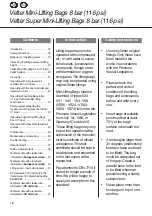
26
Warning
Risk of injuries
from broken metal
parts and stones.
The force of the
bags may break
the rods or tear the
rod anchors out of
the wall.
Opening jammed lift
doors:
•
Push the doors apart by
approx. 3 cm (1.18 in.)
using a crowbar and
insert the bag in the
gap, then inflate slowly.
Warning
The doors may
spring open
suddenly.
Maintenance and
servicing
Check that the Mini-Lifting
Bags and accessories are
complete and in correct
working order after every
use or longer periods of
storage. Carry out visual
and functional inspections.
A detailed checklist for
visual and functional
checks is available from
Manfred Vetter GmbH &
Comp. on request.
Mini-Lifting Bags can be
cleaned with soap and
warm water. The lifting bags
should then be dried at
room temperature.
Hydrocarbons may not be
used for cleaning.
Carefully inflate Mini-Lifting
Bags after use or after
longer periods of storage
starting with 0.5 bar (7.25
psi) and check for dam-
ages. If no damages are
found, e.g. punctures or
cracks, increase the
pressure to a maximum of
4 bar (58.39 psi).
If punctures or cracks
appear which expose the
steelcord or kevlar the bags
are no longer suitable for
use. They cannot be
repaired for safety reasons.
Damages to the bag’s
nipple
If the nipple is damaged it
can be replaced.
Heat the area around the
nipple with a hair dryer to
loosen the adhesive.
Unscrew the nipple by
applying a slight pressure
whilst holding the thread
tight in suitable spanners.
Life span
Mini-Lifting Bags are rubber
products and are thus
subject to natural aging
processes. Even if the bags
show no visible signs of
wear or damage they
should be replaced after 10
years since invisible ageing
processes may have taken
place in the composite
material.
If bags which are older than
10 years old are never-
theless used, the tester
decides on whether shorter
maintenance intervals are
necessary. A pressure test
every 2 years is
recommended.
Vetter Mini-Lifting Bags 8 bar (116 psi)
Vetter Super Mini-Lifting Bags 8 bar (116 psi)


















